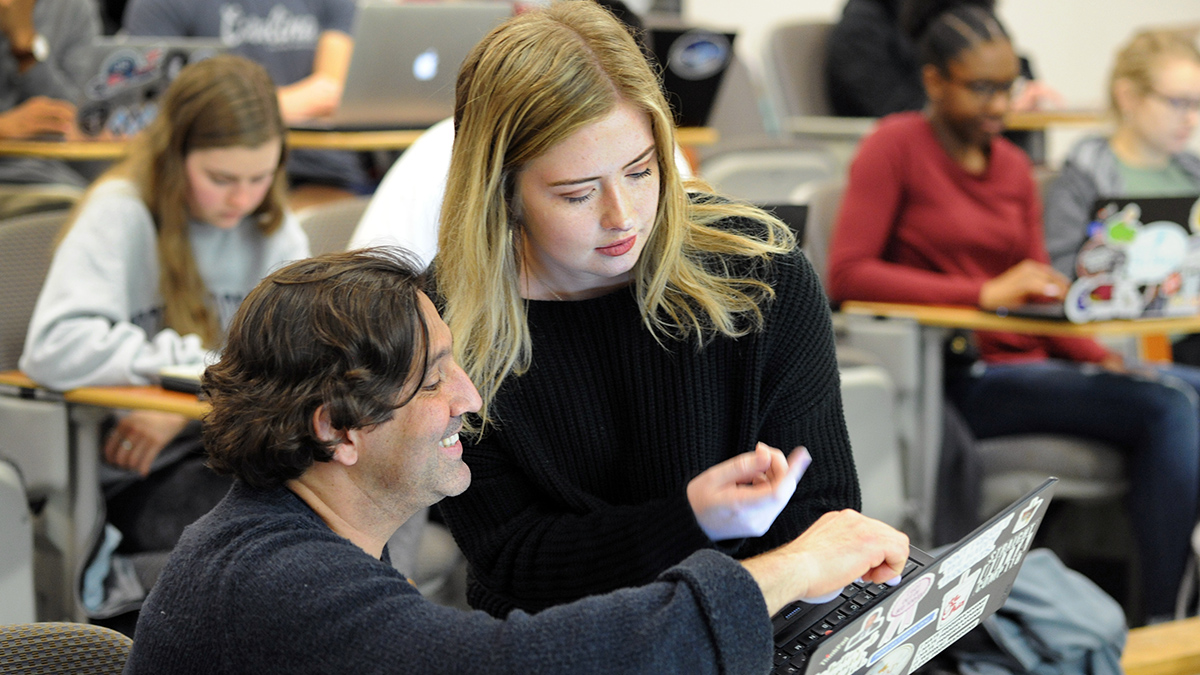‘Triple I’ courses teach the power of interdisciplinary thinking
The College’s “Triple I” courses are being pilot-tested this semester. The large classes are organized around a broad theme and are team-taught by faculty members in three disciplines.

Before high school track star Colin Thompson was set to begin his college career at Carolina, he was in a car accident that left him with a severe traumatic brain injury. He had to relearn how to walk, talk and eat.
Thompson’s positive attitude and determination in the face of serious life obstacles made him the perfect guest speaker for a new interdisciplinary course in the College of Arts & Sciences called “Health and Happiness.”
“Happiness is the path you are on,” said Thompson, a senior exercise and sport science major who was invited to speak by professor Claudio Battaglini. “Capitalize on the opportunities you have in front of you.”
Earlier that morning, students had gathered in a similar “big ideas” class with a heavier topic — “Death and Dying.” Teaching professor Jeannie Loeb invited students to respond to a question via Poll Everywhere software, which encourages interactive class participation in real time. She asked: “What are your favorite ways of distracting yourself from a distressing situation when you get extremely upset?”
Netflix, exercise, music, dogs and cats surfaced on a big screen. Instructors discuss serious topics like suicide prevention, funeral customs and euthanasia, but try to end each class on a lighter note.
Ideas, information and inquiry
“Health and Happiness” and “Death and Dying” are two of five “Ideas, Information and Inquiry” courses, called “Triple I” or “III” for short, that are being pilot-tested this semester. The large classes are organized around a broad theme and are team-taught by outstanding faculty members in three disciplines.
Triple I courses are core offerings in the proposed new General Education curriculum — IDEAs in Action. The courses would be required for first-year students and encouraged for transfer students.
Additional spring courses include “Philosophy, Politics and Economics,” “The Idea of Race” and “The Environment, Intersectionality and Science Fiction.”
Interdisciplinary benefits
Loeb (psychology and neuroscience) teaches “Death and Dying” with Tim Marr (American studies) and Jocelyn Chua (anthropology). Death and dying are shared experiences, yet there is great cultural variation in the ways people define, understand, and treat death and dying.
Human problems are inherently interdisciplinary, and the Triple I courses highlight that.
“Being able to work with people from different disciplinary backgrounds to create solutions to complex human problems is important, especially in an increasingly global world,” Chua said.
Battaglini (exercise and sport science) teaches “Health and Happiness” with Barbara Fredrickson (psychology and neuroscience) and Arne Kalleberg (sociology). In the course, students are exposed to the ideas of happiness and well-being from the disciplines of physiology, positive psychology and sociology. They are also learning important life skills such as cultivating teamwork, developing social connections, being physically active and more.
The three “Happiness” professors said students are not the only ones who benefit from the interdisciplinary nature of Triple I courses. They said teaching the class together has given them new insights about teaching styles and ways to team up for future research.
“The most interesting and pressing questions that face us in social and hard sciences require interdisciplinary approaches,” Fredrickson said.
Engaging students
Faculty members are using a variety of techniques to encourage class participation and to make these big classes feel small.
In “Health and Happiness,” students are divided into “flocks” (groups of Rams) and required to do happiness-promoting activities together outside of class. The faculty trio also hosts non-alcoholic “happy hours” where students can chat with them informally after class, and they offer tours of exercise and sport science laboratories.
The “Death and Dying” team encourages students to answer questions on index cards, then gather in small groups to trade cards with a class member they don’t know to discuss their responses. Students are also working to create a WordPress site.
Raymond Chen, a student in “Death and Dying,” said he appreciates the variety of topics addressed in the syllabus.
“One day we’ll talk about the history behind stand-your-ground laws; another day we’ll read an article on cryonics. We also learned how suicide takes on many cultural forms,” he said.
After a tough fall semester, Chika Adiele said she enrolled in “Health and Happiness” with the goal of adding to her “happiness toolbox.”
“My favorite part of the course so far was the day Dr. Battaglini talked about the physiological benefits of exercise in terms of our happiness and health,” she said. “It was mind-blowing.”
Read a longer story on the College web site.




